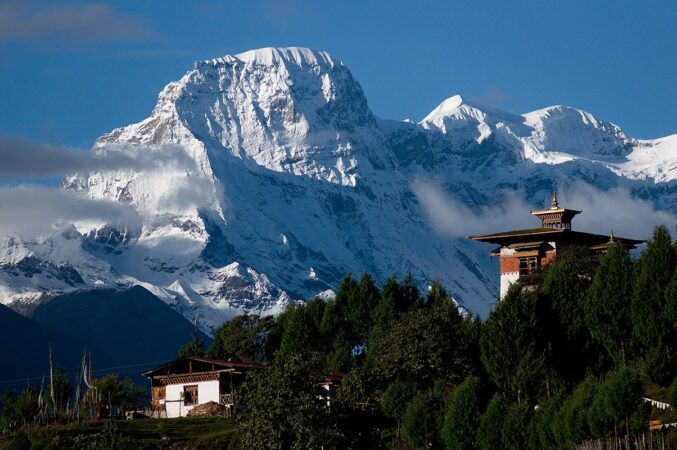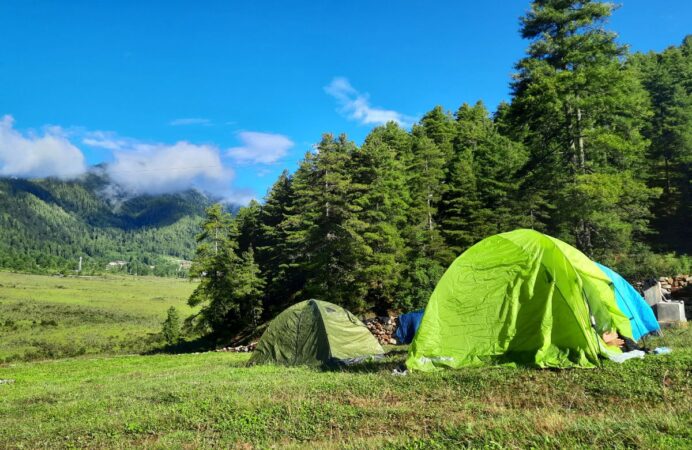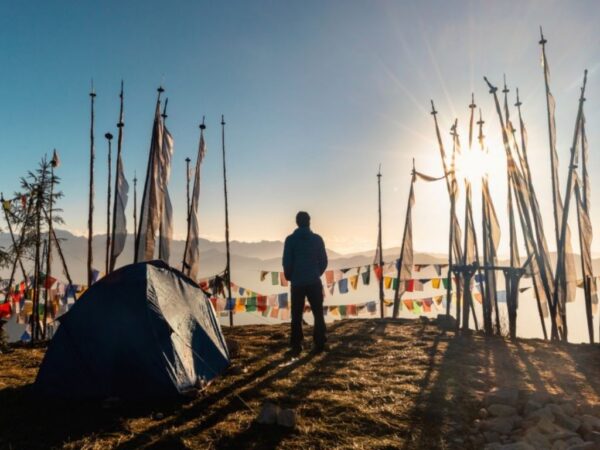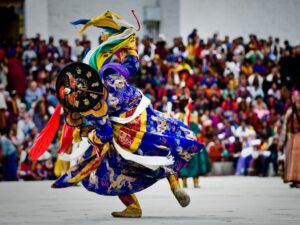Overview
Set off on an extraordinary 24-day trek that takes you through Bhutan’s most stunning terrains, from soaring mountain peaks to serene alpine meadows and remote villages. Starting in Gunitsawa Village, this challenging journey navigates high-altitude passes, deep valleys, and dense forests. You’ll be rewarded with unforgettable views of Bhutan's renowned mountains, including Mount Jomolhari and Gangkhar Puensum, as you venture through untouched wilderness and experience the culture of isolated communities such as Laya and Thanza. With a combination of tough climbs and restful days, this trek offers an unparalleled immersion in Bhutan's natural splendor and rich cultural tapestry.
Included/Excluded
- The Bhutan SDF
- All accommodations
- Meals and mineral water
- A licensed English-speaking guide
- A driver and vehicle
- Air fare
- A visa fee of US $40
- Alcohol
- Gifts/Souvenirs
- Travel insurance and personal bills
- Museums & Monument Fees
Tour Plan
Day 1: Gunitsawa Village – Sharna Zampa
The adventure kicks off at Gunitsawa Village, where you will cross an army post for a permit check. Your campsite lies across the river near Sharna Zampa.
Day 2: Sharna Zampa - Thangthangkha
Today’s trek includes frequent ascents and descents, as the path follows the river and narrows before descending into a tranquil meadow where you’ll camp for the night.
Day 3: Thangthangkha – Jangothang
If the weather was cloudy the previous day, you may catch your first glimpse of Mt. Jomolhari in the morning as you continue along the Paro Chhu Valley, reaching expansive alpine meadows.
Day 4: Rest Day at Jangothang
Enjoy a day of rest and exploration at Jangothang, with options for short hikes offering spectacular views of snow-capped peaks and alpine lakes. Keep an eye out for blue sheep grazing on the slopes.
Day 5: Jangothang – Lingshi
This day includes a steep initial climb, followed by a more moderate ascent leading to the Nyilila Pass (4,870m), with far-reaching views of the surrounding peaks.
Day 6: Lingshi – Chebisa
A shorter day of trekking, this route takes you to a chorten below Lingshi Dzong. You’ll have time to relax and take an optional scenic detour.
Day 7: Chebisa – Shomuthang
Your trek begins with a long ascent behind Chebisa, passing through wide pasturelands. You may encounter yak herders as you climb toward Gobu La.
Day 8: Shomuthang – Robluthang
Today’s journey brings you to stunning views of Kang Bum (6,526m) and carpets of edelweiss flowers. The path ascends to Jhari La (4,750m) before reaching your campsite.
Day 9: Robluthang – Limithang
Climb through boulder fields and reach Sinche La (5,005m), one of the highest points on the trek, before descending to Limithang for the night.
Day 10: Rest Day at Laya
Take a break in the village of Laya, known for its unique culture and beautiful surroundings. Recover your energy before continuing the trek.
Day 11: Laya – Rhoduphu
After leaving Laya, follow the river before gradually ascending toward Rhoduphu. The trail offers sweeping views as you make your way to the campsite.
Day 12: Rhoduphu – Narethang
Climb through a high, open valley with amazing views of Bhutan’s mountain ranges. Continue toward Tsomo La, where stunning vistas of Mount Jomolhari and Jichu Drake await.
Day 13: Narethang – Tarina
The trek continues to Gangla Karchung La (5,120m), where you’ll be treated to breathtaking views of the mountain range, including Jekangphu Gang (7,100m).
Day 14: Tarina – Woche
Descend through lush forests and follow the Pho Chhu, passing scenic waterfalls. The path climbs over ridges before descending into the village of Woche.
Day 15: Woche – Lhedi
Trek through juniper and fir forests, ascending to Keche La Pass (4,650m) for yet another mesmerizing view of the surrounding peaks.
Day 16: Lhedi – Thanza
Enjoy clear views of Table Mountain (7,100m) as you trek past the village of Chozo, where you can see an ancient dzong still in use today.
Day 17: Rest Day at Thanza
Explore the village life of Thanza or hike to a ridge for stunning mountain and lake views. Use this time to rest before the next leg of the trek.
Day 18: Thanza – Danji
The trail ascends from Thoencha, offering spectacular views of nearby villages and towering peaks.
Day 19: Danji – Tshochena
Cross a creek and climb steadily to Jaze La (5,150m), where you’ll be rewarded with panoramic mountain views before descending to the campsite at Tshochena.
Day 20: Tshochena – Jichu Dramo
The path follows the shore of a blue-green lake, climbing to a ridge at 5,100m. Enjoy views of glacial lakes as you make your way to Jichu Dramo.
Day 21: Jichu Dramo – Chukarpo
Begin with a steep ascent through a moraine to reach Rinchen Zoe La (5,320m), where you’ll be rewarded with sweeping views of Gangkhar Puensum.
Day 22: Chukarpo – Thampe Tsho
The path descends through yak herder camps before a final climb to Thampe Tsho, a beautiful turquoise lake.
Day 23: Thampe Tsho – Maurothang
Climb to Thampe La (4,600m), then descend to the sacred lake of Om Tsho before reaching Maurothang.
Day 24: Maurothang – Sephu
On your final day, descend along the Nikka Chhu to the village of Sephu, where yaks will be replaced by horses for the journey's end.
Tour Map
Frequently Asked Questions
Bhutan is a year-round destination. There are four seasons: summer (June to August), autumn (September to November), winter (December to February) and spring (March to May). But because of the range of altitudes in the country, and the influence of the north Indian monsoons, the climate is incredibly varied.
In the south, the humid, subtropical climate is fairly consistent year-round, with temperatures between 15oC and 30oC. Central Bhutan, with its temperate forests, has a more seasonal climate, with warm summers and cool, dry winters. The northern regions are much colder during winter. Because of the high altitude, mountain peaks are snowy year-round and the lower reaches remain cool in summer.
In summer, the Indian monsoon season runs from late June or July to late September, mostly affecting the southern regions. Most farming activities take place in the summer, when crops thrive in verdant landscapes.
Autumn, from late September or early October to late November, follows the rainy season. It is characterised by bright, sunny days and some early snowfall at higher elevations. It’s the season of feasts and festivals as farmers reap the fruits of their work.
From late November until March, the crisp, clear and sunny winter sets in, with frost throughout much of the country and snowfall common above elevations of 3,000 metres. The winter northeast monsoon brings gale-force winds at the highest altitudes through high mountain passes, giving Bhutan the name Drukyul, which means Land of the Thunder Dragon in Dzongkha (Bhutan’s national language).
Bhutan’s generally dry spring starts in early March and lasts until mid-April. It is a botanist’s delight, with nature in full bloom. Summer weather commences in mid-April with occasional showers and continues to late June.
Visitors of all nationalities, except those from India, require a visa before entering Bhutan. For all visitors, except those from Bangladesh and the Maldives, this visa must be applied for and approved in advance of travel. Visitors from Bangladesh and the Maldives also require a visa, but this can be applied for and approved either in advance of travel or upon arrival in Bhutan.
Visitors from India are able to apply for a permit but are required to hold an Indian passport or an Indian voter ID card. For Indian nationals under the age of 18, a passport or a birth certificate can be used to enter and they must be accompanied by a legal guardian.
Nationals from Switzerland and Thailand holding diplomatic or government-official passports are eligible for a visa at their port of entry.
A correctly input visa application can take up to five days to process.
There is a one-off fee of US$40 for the processing of your application. This is payable at the same time as your Sustainable Development Fee (SDF), as part of the process of submitting your visa application.
All treks must be undertaken with an accredited tour operator or guide. Your tour operator will assist you with all the necessary logistics and safety precautions.
Please contact our hosts for the Department of Tourism’s list of approved tourism services.
The Sustainable Development Fee (SDF) is a daily levy paid by visitors to support Bhutan’s development. Since the kingdom first opened its doors in 1974, guests have played a critical role in our country’s growth.
The SDF is collected by the national exchequer and funds are allocated to various projects that create long-term, sustainable opportunities for the Bhutanese people, through free healthcare, education and training, upskilling the tourism and hospitality industry, improved infrastructure, environmental preservation and conservation, cultural preservation programmes and initiatives that support local businesses and economies. The SDF is also a vital means of maintaining the exceptional forest cover and carbon-neutrality for which our small nation is world-renowned and globally critical. The SDF also helps us to ensure that we can continue to offer guests tranquillity and an intimate experience.
The SDF is USD 100 per night for adults from all countries except for India. Children aged between 6 years and who have not yet turned 12 are eligible to pay USD 50 per night. Children who have not yet turned 6 years old do not have to pay any SDF.
The SDF for Indian nationals (showing a valid Indian passport or Voter ID card) is Nu. 1,200 (or the equivalent amount in Indian rupees) per person, per night. Children aged between 6 years and who have not yet turned 12 are eligible to pay Nu./INR 600 per night. Children who have not yet turned 6 years old do not have to pay any SDF.
SIM cards can be purchased from the Paro International Airport’s visitor information centre on arrival, or from branch offices of Bhutan Telecom and TashiCell, or from authorised agents in towns.
There are no rules about what visitors should wear. However if you are planning to visit places of religious significance, respectful smart-casual clothing that covers your body from shoulders to knees is appropriate and appreciated.
Yes, permits are required to enter National Parks in Bhutan. However the process can be done online and the permit should be issued quickly. Please visit this link for more information: https://docs.google.com/forms/d/e/1FAIpQLScM4k5SPaGI_GnV6NJuQHstpS5ai9G4wOlpLSq0fsy73EZK7A/viewform
While most monuments in Bhutan are free, some are chargeable. For the full list of monument fees, please click here for more information. Children below 18 years will have a 50% concession and children aged five years and below will be exempted. Most monuments are open from 9am – 5pm each day. In June 2023 it was announced that foreign visitors can now visit monuments whenever they are open to the general public, without any restrictions.















